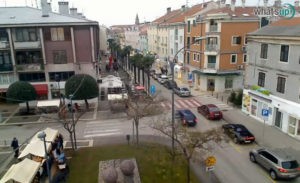Description
Live Web Cam - Kamere uživo iz Hrvatske - Web Kamere Uživo - Web Cam in diretta - Web Cam Live - Web Cam in Croatia - Webcam in Kroatien - Webcam in Croazia
Umag-Trgovačka ulica - Live Cam Croatia - Web Kamera uživo iz Hrvatske - Panorama - Web Cam - Weather Cam
Umag (Croatian pronunciation: [ûmaɡ]; Italian: Umago) is a coastal city in Istria, Croatia. The city hosts a yearly ATP tennis tournament on clay courts
Geography
It is the westernmost city of Croatia, and the municipality includes Savudrija, the westernmost point of Croatia.
Population
| Historical population of Umag–Umago |
||
|---|---|---|
| Year | Pop. | ±% |
| 1880 | 4,536 | — |
| 1890 | 5,071 | +11.8% |
| 1900 | 5,689 | +12.2% |
| 1910 | 6,548 | +15.1% |
| 1921 | 6,858 | +4.7% |
| 1931 | 7,704 | +12.3% |
| 1948 | 7,103 | −7.8% |
| 1953 | 6,896 | −2.9% |
| 1961 | 7,554 | +9.5% |
| 1971 | 8,160 | +8.0% |
| 1981 | 9,936 | +21.8% |
| 1991 | 12,348 | +24.3% |
| 2001 | 12,901 | +4.5% |
| 2011 | 13,467 | +4.4% |
| Source: Naselja i stanovništvo Republike Hrvatske 1857–2001, DZS, Zagreb, 2005 | ||
Umag has a population of 7,769 (2001), for a total municipal population of 13,064 (2001). Like many other towns in Istria, Umag has a multi-ethnic population. Croats comprise an absolute majority with 59.6%; Italians 18.3%, Serbs 3.8%, Slovenes 2.2%, Bosniaks 1.7%, Albanians 1.3% and those regionally declared (as Istrians) make up the final 1.57%.[2]
History
Umag was mentioned for the first time in the 7th century by an anonymous citizen from Ravenna, but already existed in Roman times. Proof of that is found in the numerous remains of Roman retreats, the so-called villa rustica uncovered all along the coast. The town's history is closely linked to the settlement of Sipar whose ruins can be found on the narrow cape, six kilometres north of Umag. In the 9th century, the fortified settlement of Sipar was devastated by invaders, the Neretva pirates. However, after this unfortunate incident Umag grew in significance thanks also to its location, a small islet separated from the mainland with a narrow channel. It was actually this location that safeguarded the settlement from the continuous invasions throughout the centuries. The Roman period of relative prosperity was substituted by one of insecurity caused primarily by frequent invasions, outbreaks of plague, cholera, and malaria. The number of its dwellers declined rapidly. Umag became part of the reigns of Odoacre, Theodoric, and was also ruled by the Longobards.
From the 6th to the 8th centuries it fell under Byzantine dominion, followed by the rule of the Lombards in 751 and Francs in 774. The period to come was marked by insecurity and frequent changes of government from the Patriarchs of Grado and Aquileia to the Bishops of Trieste. However, the increasingly powerful Venetian Republic imposed its rule over Istria, forcing Umag and other western Istrian towns to swear loyalty to Venice. Actually, in 1269, the Commune of Umag promised loyalty to Venice which from that time all through 1797 was to appoint governors of Umag from among its nobility. This period was by no means a peaceful one.
Century old clashes with Genoa brought about more destruction and looting. In 1370 the Genovese navy attacked Umag, destroying the town's archive. The outbreaks of plague that decimated the dwellers forced the Venetian authorities to consider colonising the area with new settlers, mainly from the territories threatened by Turkish invasions. Through centuries of the Venetian rule Umag's economy was exclusively based on agriculture. The harbour of Umag was utilised for loading agricultural surplus from the hinterland. Up to the collapse of Venice Umag had lived like other Istrian towns. Its communal arrangement was guaranteed in the Statute from 1541.
With the fall of the Venetian Republic, Umag, like the entire eastern Adriatic coast, came under the rule of France until 1815 when it passed over to Austria until 1918. With the end of World War I Istria became part of Italy. After World War II, the flaring up of the Trieste crises resulted in the establishment of the Free Territory of Trieste, while Umag became part of Zone B governed by the Yugoslav Army, and eventually became part of SR Croatia within SFR Yugoslavia in 1954. After Umag became part of Yugoslavia, there was an exodus of many Italians from the city, who until then constituted the majority of its population.
In 1993 with the establishment of the new local rule Umag became an independent municipality (općina), and in 1997 was awarded the status of town or city (grad).
Economy
The natural features of the area have considerably influenced the development of the economy as a whole. The geographical location of Umag, in particular, has ensured an intensive and dynamic growth of the tourist industry after World War II, which has been expanding rapidly ever since. The closeness of big west European markets and the rise in standard of East European countries have both accounted for the expansion of this economic branch which is tightly linked to other economic resources in the region the most significant being agriculture. The best fertile soil and the vast arable land in the area have fostered the production of traditional Mediterranean crops present in the region for thousands of years, with particular emphasis on olive growing and wine growing.
The latter accounts for a successful winemaking industry and the emerging in recent years of a number of highly renowned local wine makers that can be traced in the wine chart of Istria. Linked with agriculture is the rapidly expanding tourist branch agro-tourism which has not only enriched the tourist offer but is also committed to preserving the old-world values of the region. Apart from that, mention must be made of the "Podravka" food factory in Umag where huge quantities of tomatoes are processed. In fact, the food industry started in Umag in the early 20th century with the opening of the "Arrigoni" plant for packing fish and tomatoes and the building of a flour mill, the predecessor of today's bakery and biscuit factory.
Today new factories have grown up in two industrial zones (Ungarija and Kravlji rt), which are provided with the necessary infrastructure continuously rebuilt and enlarged. The economic growth of Umag is based on the stimulation and support of small and medium- sized firms and the establishment of business zones. For this purpose, the town authorities have set apart 355,200.00 kuna for the program aimed at stimulating the growth of agriculture and businesses for the year 2002. Besides, Umag is the founding member of the "Istarska razvojna agencija" IDA (Istrian Development Agency), with its seat in Pula.
Live Web Cam - Kamere uživo iz Hrvatske - Web Kamere Uživo - Web Cam in diretta - Web Cam Live - Web Cam in Croatia - Webcam in Kroatien - Webcam in Croazia
Location
-
, Umag, Croatia



Add a review